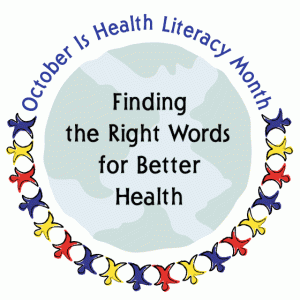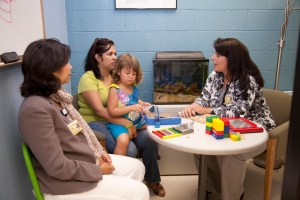Community Programs & Services – 2013 Accomplishments
October 1, 2013Red Ribbon Week 2013
October 22, 2013 What is Health Literacy? The National Patient Safety Foundation defines Health Literacy as the ability to read, understand and act on health information. It is a serious public health issue that affects all age, race and income levels.
What is Health Literacy? The National Patient Safety Foundation defines Health Literacy as the ability to read, understand and act on health information. It is a serious public health issue that affects all age, race and income levels.
What does this really mean? It means that if you have trouble reading or understanding information, your health may suffer. It means that if you are a medical provider, your patients may have trouble understanding you.
What is the impact? Patients who have trouble reading or understanding may have poorer health outcomes because:
- They are more likely to miss their appointments.
- They are less likely to fill recommended prescriptions.
- They are less likely to take their prescriptions at the right time or dosage.
- They are less likely to follow-through on recommended referrals or follow-up tests.
- They may agree to a medical procedure or surgery without fully understanding the risks.
- They may feel embarrassed and won’t ask questions to help them understand their medical problems.
 How can you tell if someone has trouble reading? If someone has trouble reading they may some of the following signs:
How can you tell if someone has trouble reading? If someone has trouble reading they may some of the following signs:
1. Behaviors:
- They have trouble filling out registration forms or leave them blank.
- They frequently miss appointments.
- They don’t follow medication instructions.
- They don’t follow-through with lab tests or referrals.
- They say they are taking their medication, but their lab results or physical exam don’t show improvement.
2. Response to Receiving Written Information:
- “I forgot my glasses. I’ll read this when I get home.”
- “I forgot my glasses. Can you read this to me?”
- “Let me bring this home so I can show my parents.”
3. Response to Questions about Medication:
- Unable to name medications.
- Unable to explain the purpose of their medication.
- Unable to explain how they should take their medication (such as, time of day or number of times per day)
 How can providers and health center staff help patients with low health literacy?
How can providers and health center staff help patients with low health literacy?
- Offer to help. Ask patients if they would like you to read registration forms or instructions to them.
- Slow down. Communication can be improved by speaking slowly, and by spending just a small amount of additional time with each patient.
- Use plain, non-medical language. Click here for suggestions of words to use and words to avoid. Click here for the Spanish version.
- Show or draw pictures. Visual images can improve the patient’s recall of ideas.
- Limit the amount of information provided— and repeat it.
- Use the “teach-back” technique. Confirm that patients understand by asking them to repeat back your instructions.
- Create a shame-free environment: Encourage questions. Make patients feel comfortable asking questions. Instead of asking “Do you understand?” try saying something like “A lot of patients have questions about _____. Is this a question you would like me to answer?”
Do you want to learn more about Health Literacy? Check out these resources:
- Partnership for Clear Health Communications and the National Patient Safety Foundation
- Ask Me 3 Campaign
- Health Literacy Consulting
- Agency for Healthcare Research and Quality – Health Literacy Universal Precautions Toolkit
Related articles
- Health Literacy Month – 2013 (engagingthepatient.com)
- Advocacy Track Workshop: Health Literacy (iuemadvocacy.wordpress.com)
- Solving the Health Literacy Issue (healthstylepress.wordpress.com)

